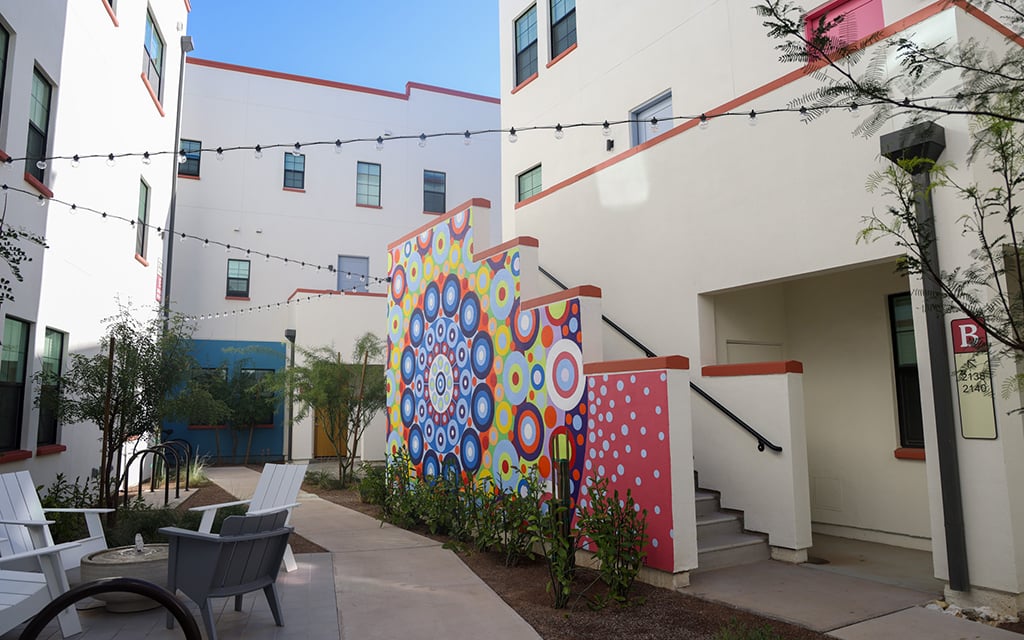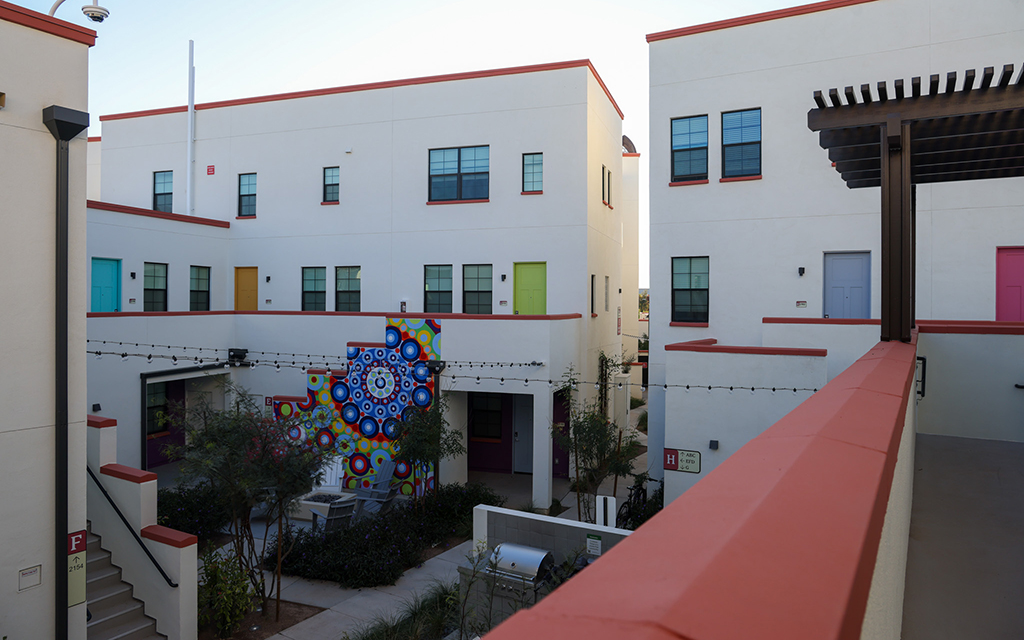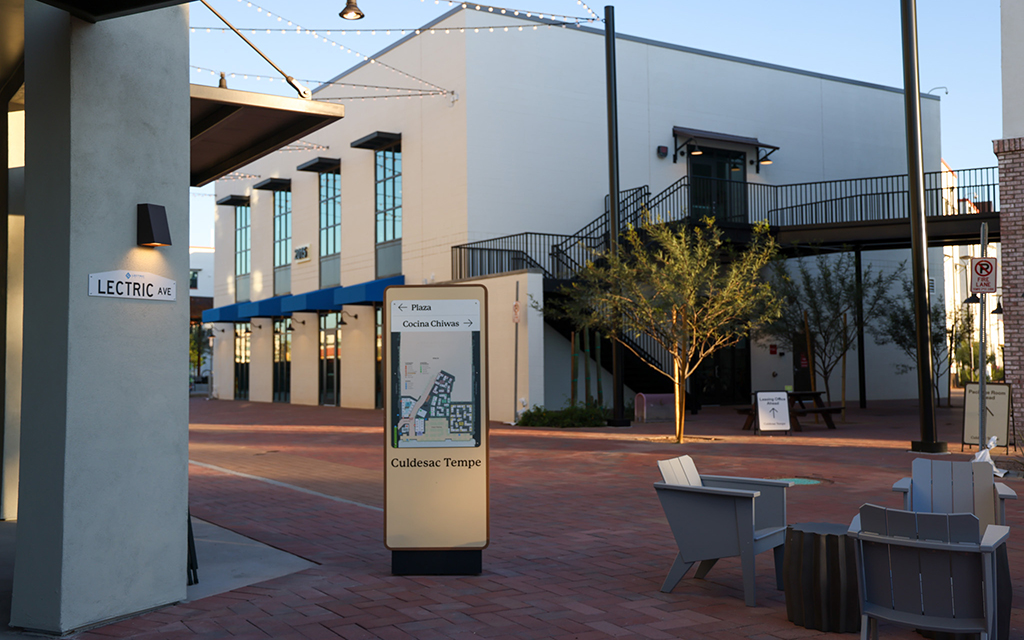
A community area inside of Culdesac features a mural by a local artist. Photo taken in Tempe on April 2, 2024. (Photo by Crystal Aguilar/Cronkite News)

Culdesac’s architecture aims to create shade to help mitigate the Arizona heat. (Photo by Crystal Aguilar/Cronkite News)

Apartments and a shared space at Culdesac, a car-free community in Tempe. (Photo by Crystal Aguilar/Cronkite News)

Stores in Tempe’s Culdesac will provide amenities in the walkable community. (Photo by Crystal Aguilar/Cronkite News)
TEMPE – Culdesac aims to offer the convenience of city living with the warm feel of the suburbs.
Located on the property is a corner market; a restaurant; several shops; a repair shop for bikes, e-bikes and e-scooters; and a night market held every Thursday to help residents connect with their neighbors and community. Apartment residents can see storefronts from their balconies and easily run down for a new outfit from vintage shop Sew Used or a gift from any of the multiple small shops. Parking is for retail convenience, rather than resident use.
Located on 17 acres, Culdesac says that as a walkable mixed-use neighborhood, it is the first car-free community of its kind in the United States. Residents are not allowed to park cars in the retail lot, and other parking is not available on site.
“We focus on mobility, community and open space, and for each of those, we have amenities we can build because we don’t have to have a big parking garage or asphalt parking lot,” said Ryan Johnson, co-founder and CEO of Culdesac, which opened to residents last year.
Studies have shown people are happier feeling like they are a part of their community and that they enjoy having a sense of connection.
“Social capital is the degree to which people feel connected and supported within their community. Individuals who reported higher levels of social capital have been found to report higher levels of wellbeing,” according to a study published in the Journal of the American Planning Association. “The way neighborhoods are planned and maintained matters for happiness, health, and trust.”

Ryan Johnson is the CEO and co-founder of Culdesac, a car-free community in Tempe. Photo taken on April 2, 2024. (Photo by Crystal Aguilar/Cronkite News)
Johnson began thinking of this concept while he was working at Opendoor, an online company that buys and sells residential real estate.
“We saw so much demand for walkable neighborhoods. People wouldn’t always ask for it by name, the word we heard the most was ‘cute,’ and when we would ask them what that means, that means they want to live by a coffee shop, they want to live somewhere with thoughtful architecture, where they know their neighbors and they want to be able to walk around,” Johnson said.
Though it’s new for the Valley, this concept has been in practice internationally, said Christoper Boone, a professor at Arizona State University’s School of Sustainability.
“Culdesac was designed with the principle of what’s sometimes called new urbanism, and it’s really – despite the name – drawing old lessons from cities that were built before cars became a dominant form of transportation,” Boone said. “It created cities that were built on what’s sometimes called a human scale so you would be able to – within half an hour – walk and find what you need.”
Though this can prove effective to improve individuals’ overall mental and physical health by encouraging community interaction and staying active, it could also help the environment by reducing the amount of greenhouse gases emitted from cars.
“Cars are very expensive, as you know; they are expensive to insure, they’re expensive to run and they are also expensive for our health. Cars are a leading cause of injury and death in the United States,” Boone said. “They also pollute our air, they use up a huge amount of space in our cities as well. So if you look at roads in most cities, they take up 30% of the area. What if we could use that 30% not for places to be driving 45 miles an hour, but for other kinds of uses like for places to sit and eat and watch the world go by?”
In order to ensure the car-free community works in Tempe, residents have access to an unlimited public-transit pass. Residents can catch the light rail right outside of the property and get discounts for Lyfts and Waymos. The community opened to residents last May, with free e-bikes for the first 200 – about 180 residents have moved in.

Culdesac is a new pedestrian-friendly community in Tempe. Photo taken on April 2, 2024. (Photo by Crystal Aguilar/Cronkite News)
Johnson said the project is an ongoing effort to change how housing is perceived and built throughout the U.S. to give people the experience of living with more spatial awareness and sense of community.
“Arguably, the best thing we could be doing for climate is getting as many people living in walkable neighborhoods as possible,” Johnson said. “When you build like this, and you put more great amenities nearby, it changes patterns and this is part of unlocking us to build more sustainable cities.
“Part of our plan is not just to build more for ourselves, it’s to show other developers in the cities that this is a model. This has become the reference project for how to build walkable neighborhoods successfully in the U.S. in the 2020s, and we want everyone to copy it.”
Another factor Johnson and the team took into consideration for the project is the Arizona heat. When asked how Culdesac will work around the high summer temperatures, Johnson said, “We don’t have the heat island effect. This apartment complex is 15 degrees cooler than the apartment complex next door, and that’s for three reasons: One is there is not a drop of asphalt on the site, second is the color of the buildings reflects heat, and the third is that the design creates lots of shade and so this is part of mitigating the heat effect.”
Boone said Culdesac’s architecture is inspired from other dry, hot climates around the world. It is built with people’s necessities in mind and finds ways to combat heat, such as providing extra shade and more breeze.
“There’s alternative ways of living that are not so dependent on cars and single-family homes, but if we really wanted to make a dent in those issues, whether it’s the environment, physical and mental health or climate change, we need to see these kinds of ideas scale quickly, and they need to increase in magnitude much, much greater than they have today,” Boone said.
There’s more for Culdesac as only part one of three has been completed in Tempe. Though the completion timeline is not yet available, the final project is expected to host around 1,000 residents.
